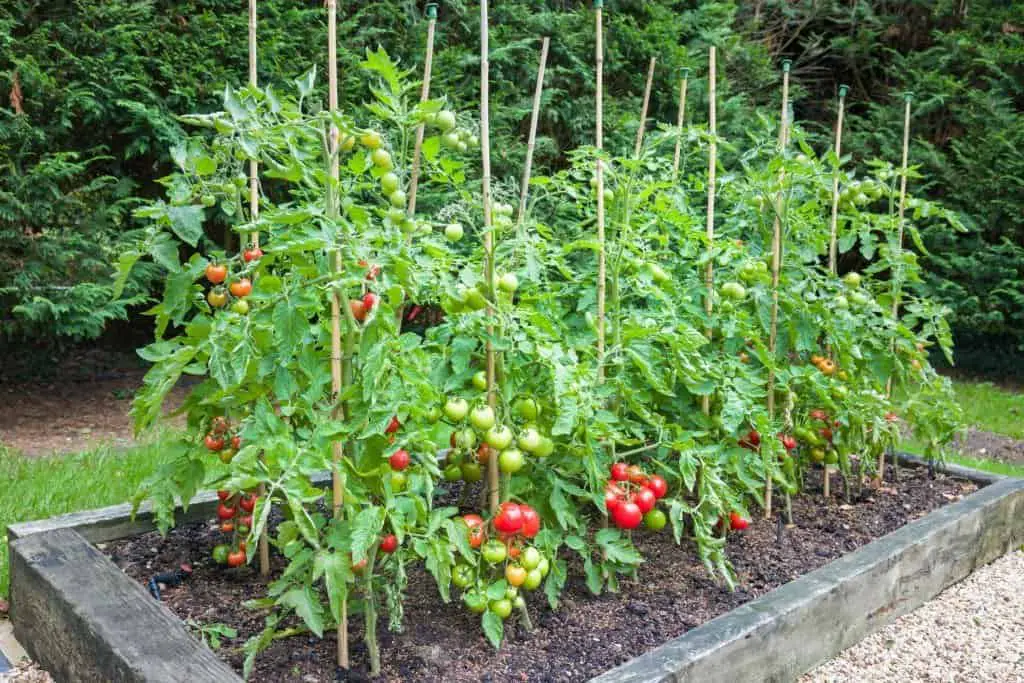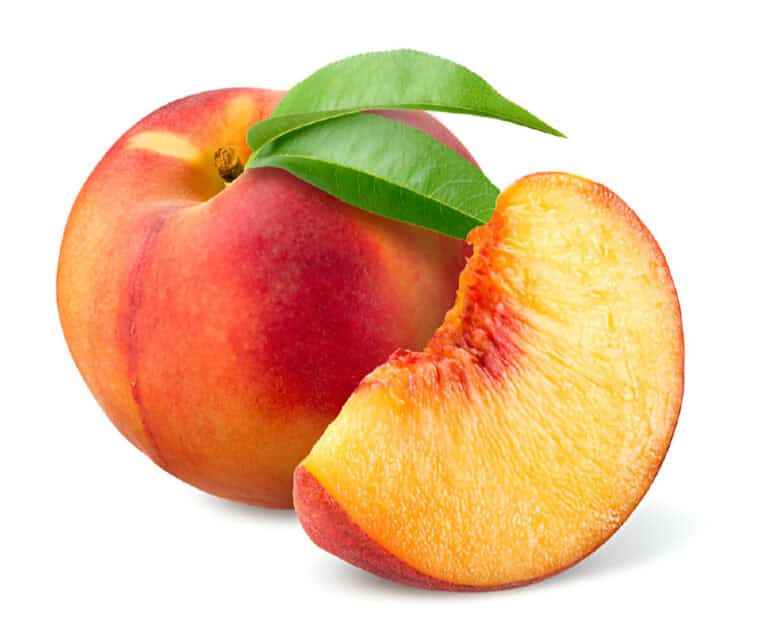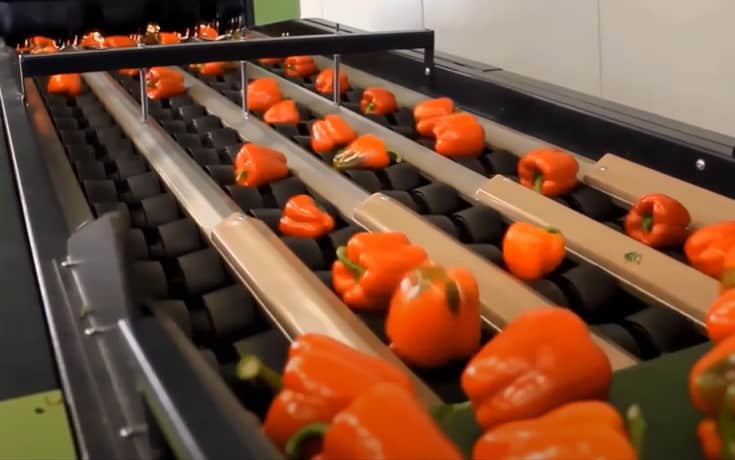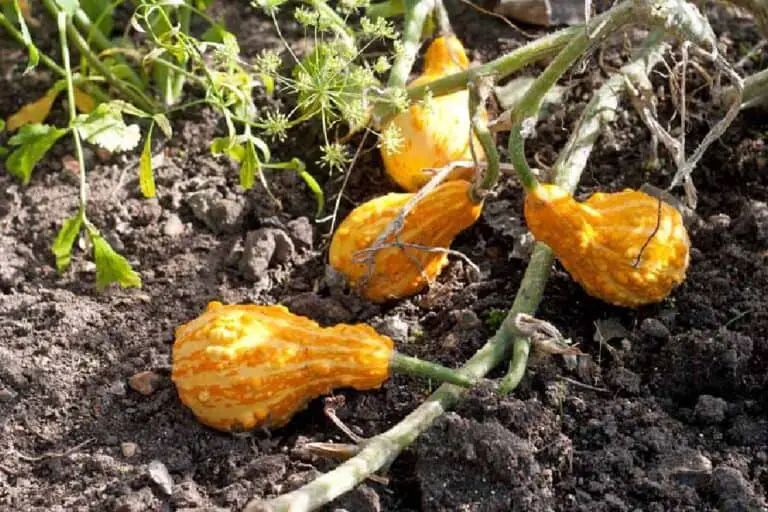Tomato Plants Stake Support: Why It’s Needed, Advantages & Disadvantages

If you’re growing tomatoes, you’ll need to provide some type of support for the plants. Just like any other plant, tomatoes need support to grow properly. Without support, the plant will become weak and produce less fruit.
There are many different ways to provide support for your tomato plants. The most common way is to use the staking method.
Staking is one of the most common methods of tomato plant support. When done properly, staking can help your plants produce healthier fruit and prevent damage from wind and heavy fruits.
In this article, we’ll discuss why tomato plants need stake support. In addition, we walk you through how to use and set up tomato plant stakes.
Determinate vs. Indeterminate Tomatoes: What’s the Difference?
Determinate tomatoes are hybrids that have been bred to stop growing at a certain point, usually when the fruit has reached its full size.
On the other hand, indeterminate tomatoes keep growing and making fruit until it gets cold enough to kill them.
So, why is it important to know the difference between these two types of tomatoes?
For one, it can help you determine how to best care for your tomato plants. For example, determinate tomato plants don’t usually need as much pruning or support as indeterminate varieties. Additionally, knowing which type of tomato you have can help you better predict when your plants will produce fruit.
Whether you choose determinate or indeterminate tomatoes is up to personal preference. However, it’s still important to know the difference between the two so that you can give your plants the best possible care
Is It OK Not to Stake Tomato Plants?
When it comes to growing tomato plants, many gardeners choose to stake them as a way to provide support and promote healthy growth. However, it is possible to grow tomato plants without staking them. The question is, “Is it okay not to stake tomato plants?”
Yes, you may opt not to stake your tomatoes. Like anything else, there are pros and cons to not doing so.
Pros:
One of the main benefits of not staking tomato plants is that it can save time and effort. Without the need to set up and maintain a stake support system, gardeners can focus on other aspects of their garden. Additionally, not staking tomato plants can save space in the garden, as they can be grown closer together and take up less room.
If you don’t stake tomato plants, their roots can get stronger, which is another benefit. When tomato plants are allowed to sprawl on the ground, they must work harder to find nutrients and water, leading to a stronger and more resilient root system. This can make the plants more resistant to pests and diseases.
Cons
However, there are also some potential drawbacks to not staking tomato plants. Without support, the plants are more likely to get hurt by wind, heavy rain, or other things in the environment.
Not staking tomato plants can also lead to problems with pests and diseases. Pests are drawn to plants that are weak or hurt, and diseases can spread faster when plants are too close together or touch the ground.
What Tomatoes Don’t Need Staking?
Some tomatoes, such as the determinate variety, do not need to be staked. Determinate tomatoes are shorter and bushier than indeterminate tomatoes, and they produce all of their fruit at the same time.
This makes them ideal for small gardens or containers. If you are growing determinate tomatoes, there is no need to stake them; simply let them grow on the ground or in a pot without support.
How to Use Tomato Stake Support the Right Way
A tomato plant can get quite big and make a lot of tomatoes, so it needs to be staked to keep it healthy and keep it from falling over.
There are a few different ways to stake a tomato plant, but the simplest method is to use a single stake placed in the ground next to the plant.
- Make sure the stakes are strong enough to support the weight of the plant and fruit.
- Drive the stakes into the ground deeply enough so they won’t blow over in strong winds. Drive the stake into the ground about 6 inches from the tomato plant, making sure that it is at least 2 feet taller than the plant.
- Place the stakes close enough to the plant so that it can get adequate support but not so close that it will be difficult to harvest the fruits.
- As the plant continues to grow and produce fruit, you may need to add additional stakes or supports. If you do, make sure that they are spaced evenly around the plant so that it is evenly supported.
If you follow these simple tips, you’ll be able to use tomato stake supports well and keep your plants from getting sick.
Advantages of Tomato Plants’ Staking Support
Staking tomato plants has many advantages that make the extra effort worthwhile.
- To protect the fruit from rotting on the ground, tomato plants are staked.
- It also prevents the plants from being clamped, which allows for better air circulation and prevents fungal diseases.
- Staked tomato plants are also less likely to be damaged by wind or heavy rain.
- Staking promotes the earlier harvest of larger fruit. To accomplish this, staked tomatoes require pruning. This gives plants the attention of the gardener in order to force more plant energy into ripening tomatoes.
- Staking makes it simpler to maintain the plants and monitor insects.
Disadvantages of Tomato Plants’ Staking Support
There are several disadvantages to tomato plants’ staking.
- Tomatoes are more prone to cracking, water stress, blossom end rot and sunscald because they are more exposed.
- Compared to plants that are allowed to grow naturally, tomato plants that are staked are typically smaller. Generally overall yields from staked plants are the lowest of all the methods of support.
- Staked plants require vigilance with training as they grow. The setup, pruning, and training of staked tomatoes may be the most time conconsuming of all the methods.
- When staking tomato plants, care must be taken to not damage the stem or leaves. If the plant is damaged, it may not produce as many tomatoes.
It is important to choose the right materials for staking and take the time to properly stake the plants so they will grow healthy and productive.
The Different Types of Tomatoes Stake Supports
The different types of stake supports for tomato plants include bamboo stakes, wooden stakes, and trellis systems. Each type has its own pros and cons that you should think about when deciding which is best for your tomato plants.
1. Bamboo Stakes
Bamboo stakes are often used by gardeners because they are cheap, light, and durable. They are also easy to cut to the length you want and can be found at most garden centers. However, bamboo stakes are not as strong as wooden stakes and may not be able to support the weight of a heavy tomato plant.
2. Wooden Stakes
Wooden stakes are stronger and more durable than bamboo stakes, making them a good option for larger or heavier tomato plants. They can be cut to the desired length and painted or stained to match the surrounding garden. But wooden stakes aren’t as easy to find and can be more expensive than bamboo stakes.
3. Plastic Stakes
Plastic tomato stakes are a light and inexpensive way for gardeners to solve this common gardening problem.
Plastic tomato stakes come in various shapes and sizes, from small single posts to larger supports with multiple arms. This variety makes it simple for gardeners of any skill level to find just what they need for their plants. The plastic is also durable enough to last through all kinds of weather conditions, ensuring that your tomatoes receive season-long support.
4. Metal Stakes
Using a metal stake is one of the most effective ways to ensure that your tomato plants stay healthy and produce plenty of fruit throughout the growing season.
Metal stakes are an ideal choice for tomato supports because they are strong enough to handle heavier plants and fruits. They also provide superior stability over other materials, such as wood or plastic.
INFO![]()
For larger tomato varieties, metal stakes can be used in combination with other supports, such as string or trellises, so that the plant is well-supported from every direction. As an added bonus, metal stakes will not rot in wet conditions like some other materials may.
5. Trellis Systems
Trellis systems give tomato plants a more complex way to hold themselves up so they can grow. A variety of materials, such as wood, metal, and plastic, can be used to create them. Trellis systems can be more expensive than wooden or bamboo stakes, but they can support more than one plant at once and let more air flow through the garden.
Furthermore, they take up less room in the garden. Tomato plant trellis support, on the other hand, can be more difficult to install and may not be appropriate for every garden.
It’s important to consider the size, weight, and growth habit of your tomato plants when choosing the best stake support system. The best option is to try different types of support systems and see which one works best for your plants and your garden.
Conclusion
In conclusion, staking and caging tomato plants is an important step in ensuring that the plants stay upright and healthy. By giving the tall, top-heavy plants something to stand on, you can keep them from falling over and breaking.
Also, staking or caging tomato plants can have other benefits, like letting in more air and making it easier to pick the tomatoes. However, it’s also important to keep in mind that staking or caging also has some disadvantages, like extra work and increased cost, and it could also be an obstacle for the pests.







